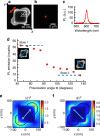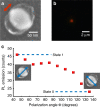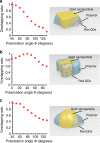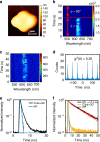Hybrid plasmonic nano-emitters with controlled single quantum emitter positioning on the local excitation field
- PMID: 32641727
- PMCID: PMC7343831
- DOI: 10.1038/s41467-020-17248-8
Hybrid plasmonic nano-emitters with controlled single quantum emitter positioning on the local excitation field
Abstract
Hybrid plasmonic nano-emitters based on the combination of quantum dot emitters (QD) and plasmonic nanoantennas open up new perspectives in the control of light. However, precise positioning of any active medium at the nanoscale constitutes a challenge. Here, we report on the optimal overlap of antenna's near-field and active medium whose spatial distribution is controlled via a plasmon-triggered 2-photon polymerization of a photosensitive formulation containing QDs. Au nanoparticles of various geometries are considered. The response of these hybrid nano-emitters is shown to be highly sensitive to the light polarization. Different light emission states are evidenced by photoluminescence measurements. These states correspond to polarization-sensitive nanoscale overlap between the exciting local field and the active medium distribution. The decrease of the QD concentration within the monomer formulation allows trapping of a single quantum dot in the vicinity of the Au particle. The latter objects show polarization-dependent switching in the single-photon regime.
Conflict of interest statement
The authors declare no competing interests.
Figures








References
-
- Hill MT, Gather MC. Advances in small lasers. Nat. Photonics. 2014;8:908–918.
-
- Akselrod GM, et al. Probing the mechanisms of large Purcell enhancement in plasmonic nanoantennas. Nat. Photonics. 2014;8:835–840.
-
- Stockman MI. Spaser explained. Nat. Photonics. 2008;2:327.
-
- Cohen-Hoshen E, Bryant GW, Pinkas I, Sperling J, Bar-Joseph I. Exciton–plasmon interactions in quantum dot–gold nanoparticle structures. Nano Lett. 2012;12:4260–4264. - PubMed
LinkOut - more resources
Full Text Sources

